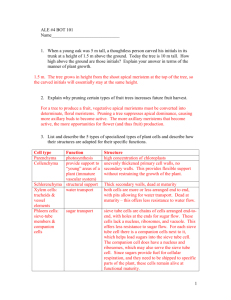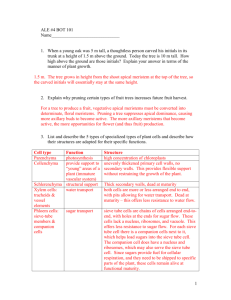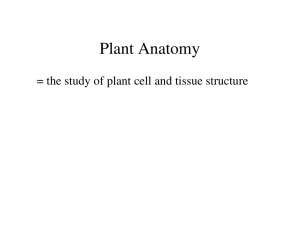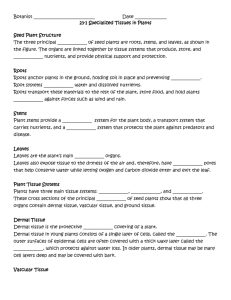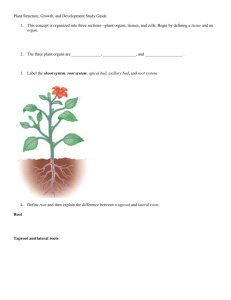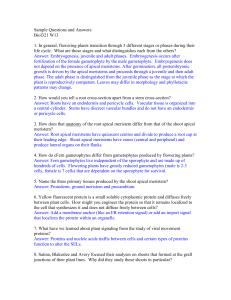ALE #3
advertisement
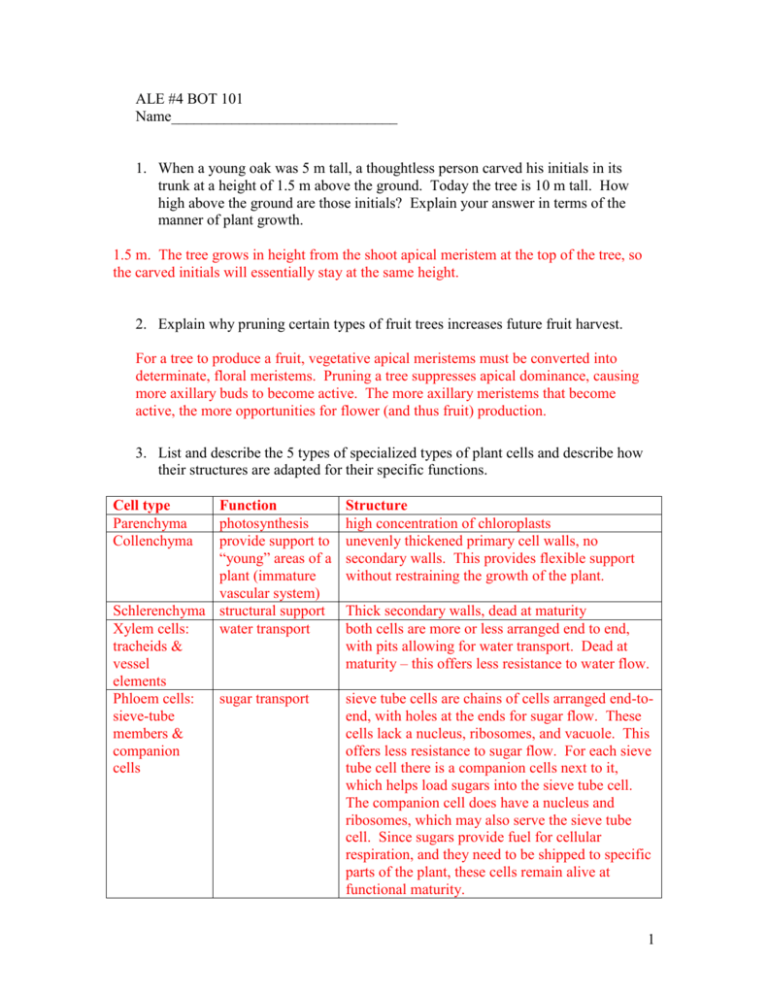
ALE #4 BOT 101 Name______________________________ 1. When a young oak was 5 m tall, a thoughtless person carved his initials in its trunk at a height of 1.5 m above the ground. Today the tree is 10 m tall. How high above the ground are those initials? Explain your answer in terms of the manner of plant growth. 1.5 m. The tree grows in height from the shoot apical meristem at the top of the tree, so the carved initials will essentially stay at the same height. 2. Explain why pruning certain types of fruit trees increases future fruit harvest. For a tree to produce a fruit, vegetative apical meristems must be converted into determinate, floral meristems. Pruning a tree suppresses apical dominance, causing more axillary buds to become active. The more axillary meristems that become active, the more opportunities for flower (and thus fruit) production. 3. List and describe the 5 types of specialized types of plant cells and describe how their structures are adapted for their specific functions. Cell type Parenchyma Collenchyma Function photosynthesis provide support to “young” areas of a plant (immature vascular system) Schlerenchyma structural support Xylem cells: water transport tracheids & vessel elements Phloem cells: sugar transport sieve-tube members & companion cells Structure high concentration of chloroplasts unevenly thickened primary cell walls, no secondary walls. This provides flexible support without restraining the growth of the plant. Thick secondary walls, dead at maturity both cells are more or less arranged end to end, with pits allowing for water transport. Dead at maturity – this offers less resistance to water flow. sieve tube cells are chains of cells arranged end-toend, with holes at the ends for sugar flow. These cells lack a nucleus, ribosomes, and vacuole. This offers less resistance to sugar flow. For each sieve tube cell there is a companion cells next to it, which helps load sugars into the sieve tube cell. The companion cell does have a nucleus and ribosomes, which may also serve the sieve tube cell. Since sugars provide fuel for cellular respiration, and they need to be shipped to specific parts of the plant, these cells remain alive at functional maturity. 1 4. How does primary growth differ from secondary growth? Primary growth involves growth in height, due to elongation of cells produced by apical meristems. Secondary growth only occurs in woody species (trees & shrubs), and involves growth in girth (circumference). It occurs when the vascular cambium produces secondary xylem and secondary phloem, and the cork cambium produces the periderm. 5. What are the three types of plant tissues and the functions of each? Dermal tissue – protection, secretion of the waxy cuticle in shoots, leaves; root hairs for absorption in roots Ground tissue – photosynthesis, storage (for starch, cellulose), and structural support Vascular tissue – xylem for transporting water & nutrients, phloem for transporting the sugars made by photosynthesis. 6. From plants and people (p 100): what are the 3 main types of plant textile fibers? Describe the difference between each, and give one example of each 1. Bast fibers (a.k.a soft fibers) – ex. Flax and hemp. These fibers are derived from the stem of the plant. These are typically spun into thread for use in fabrics. 2. Leaf fibers (a.k.a hard fibers) – These are derived from the leaves of the plant, and are used more in rope making than in fabrics. Ex. Manila hemp and sisal 3. Surface fibers – these fibers are derived from accessory structures of the seeds or fruits. Cotton is a great example! 7. From plants and people: page 117: List several root crops, and identify the 2 most important root crops world-wide. What is a biennial? The two most important root crops worldwide are cassava (manioc) and sweet potatoes. Other examples include: carrots, beets, parsnips, rutabagas, and radishes. A biennial is a plant that completes its life cycle in two growing seasons. During the first season, it only produces vegetative growth – no flowers or fruits. During this time it stores starches below ground, typically in a tap root, to be used the following spring for new growth. During the second growing season, the plant will produce flowers and fruits, and then die. 8. From plants and people page 140: Define lumber, pulp, plywood, and fiberboard. Lumber: square-edged boards that are cut from logs. They are cut into standard widths and heights Pulp: This is paper “slush.” Conifer wood is ground up, mixed with chemicals, and then pressed into giant rolls of paper. Plywood: These are thin sheets of wood, sliced from a log, and then glued together Fiberboard: This is a formed by pressing the wood pulp slush into a board 2 9. What is the difference between a hardwood and a softwood (p.140)? A softwood is another name for a conifer, and a hardwood is another name for flowering trees. 10. From plants and people page 145: what are the 3 main causes of tropical deforestation? subsistence agriculture, commercial logging, and cattle ranching 11. From Plants and people page 161: Why are leaves so sensitive to air pollution? This is because the stomata are on the leaves – the stomata are holes where the leaf takes in carbon dioxide, but there is nothing to prevent the plant from taking in all the other gasses and pollutants that may be in the air. There are no, or very few, stomata on the stems, and none on the roots. 3
